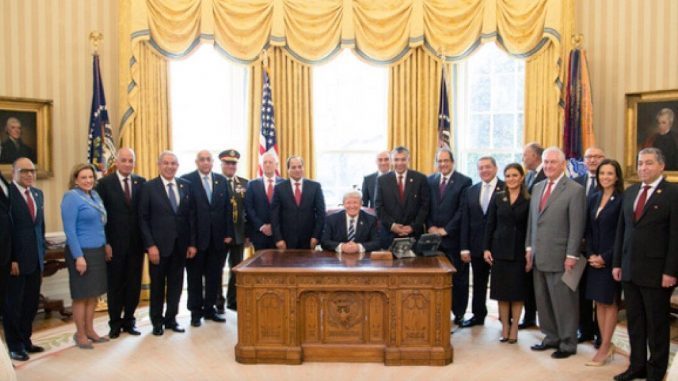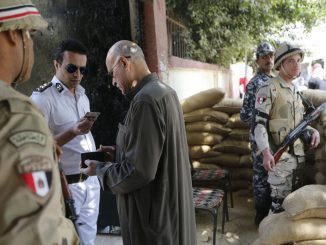
Al-Sisi’s picture standing,while U.S President is sitting on his desk, has sparked dissents on the social media.
In the picture posted on Trump’s official Twitter page, Al-Sisi appeared standing with Trump administration employees while President Donald Trump was sitting in the middle.
Activists on the social media considered the picture “humiliating” as it denies all diplomatic protocols, while others believe that it truly reflects al-Sisi’s position as a “loyal servant” to his “American Master”.
Others said that the picture showed al-Sisi as one of the Trump’s team and not as a real president.
In addition,others said that the picture humiliates Egypt’s image due to the absence of Egypt’s flag in the picture.

Abdel Fattah al-Sisi traveled to the United States of America on April 3, 2017. This the first official visit by an Egyptian head of state to the White House since 2009.
Al-Sisi, a former defense minister who overthrew Egypt’s first freely democratic elected president, Mohamed Morsi, in July 2013.
Since he seized power in a military takeover, Abdel Fattah al-Sisi was barred from the White House during Obama administration as a result of excessive crackdown on human rights .
During al-Sisi’s reign, the country oversaw the brutal dispersal of opposition protests that left more than 1,150 people dead.
Moreover, al-Sisi’s security forces have arrested tens of thousands of Egyptians and committed flagrant rights abuses, including torture, enforced disappearances, and likely extrajudicial executions, according to Human Rights Watch.
However, Al-Sisi’s visit to Washington was considered a significant step in reviving the American Egyptian relations in the coming period as there are several files of common interests between both leaders, on top of these issues is fighting terrorism and the Palestinian Israeli Conflict.
But al-Sisi’s picture as part of U.S. administration team gives an insight that al-Sisi will address these files in Trump’s own way.
H.A. Hellyer, a senior fellow at the Atlantic Council,said “Probably too much has been made of the ‘chemistry’ between Trump and al-Sisi — there are convergences of interest, and there is the absence of tension that existed with the Obama administration, but that’s about it.”
“Al-Sisi may find himself pushing back against some of the Middle East policies reportedly being considered by the Trump administration, like creating a military coalition of Sunni Arab U.S. allies against the perceived threat of non-Arab Shiite Iran,”said the Time.
According to the Time,”There has been talk of deeper U.S. involvement in the Saudi-led coalition’s fight against Shiite rebels in Yemen, with Egypt possibly being urged to contribute forces.”
It is worth to mention that Egypt has never shared Saudi Arabia’s view of Iran as a looming existential threat and has also resisted pressure from Riyadh to contribute troops to the war in Yemen. Trump’s position on Tehran seems closer to the Saudi perspective.
In this context, Trump would order al-Sisi to come closer to Saudi Arabia in order to create a Sunni Arab alliance against Iran.
Regarding the Palestinian conflict, for decades Egypt has been a staunch supporter of the Palestinians’ right to statehood.
However, Trump would push al-Sisi to abandon the Arab initiative, a Saudi peace plan adopted by Arab leaders in 2002.
The plan provides Arab recognition of Israel in exchange for its withdrawal from lands occupied in 1967, allowing the creation of a Palestinian state with east Jerusalem as its capital.
Veteran columnist Raghida Dergham wrote in the pan-Arab daily Al-Hayat that Trump could push al-Sisi to abandon this initiative and convince other Arab countries to de-emphasize the Palestinian issue.
She wrote,”What the American president wants from Egypt is to remove the Palestinian question from Arab priorities and marginalize the Arab initiative.”



